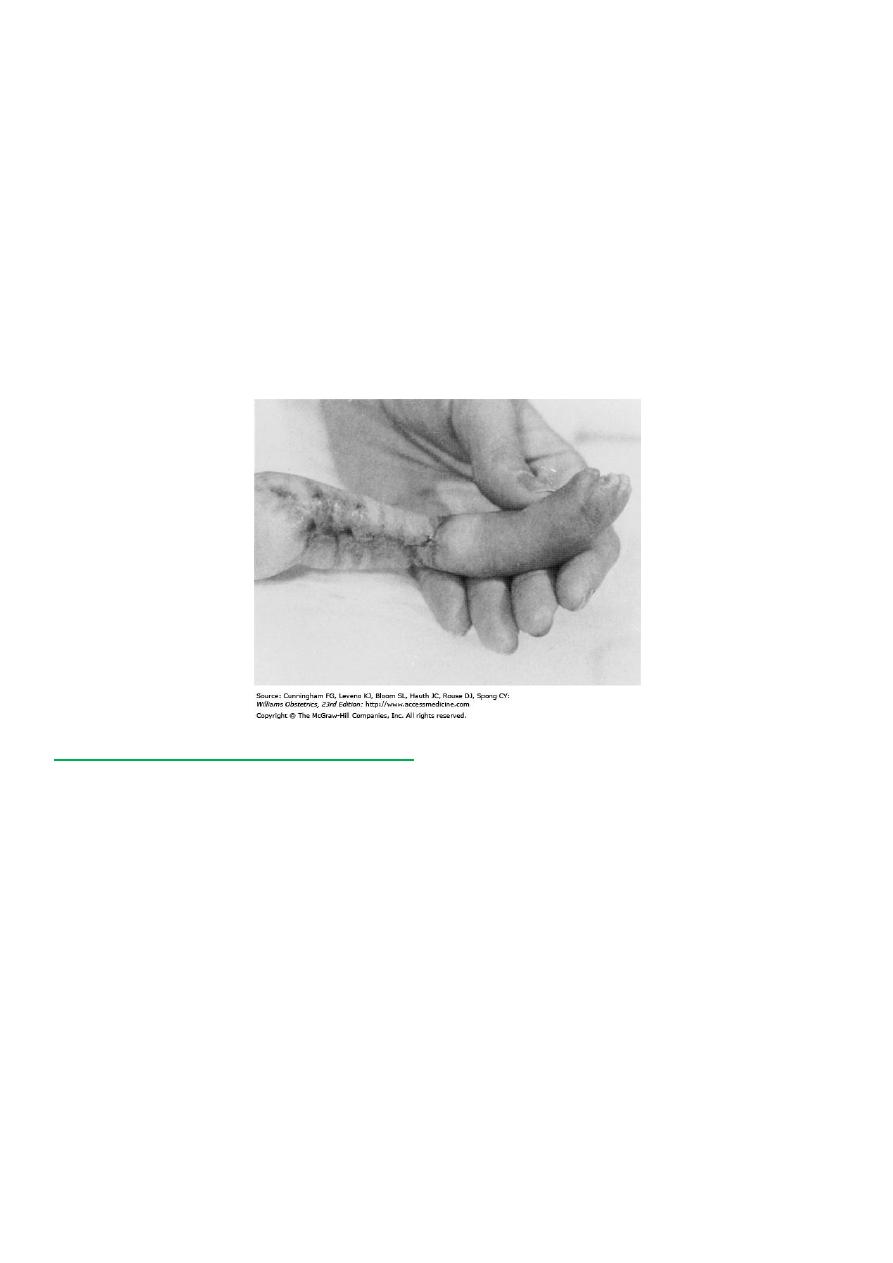
Dr.Esraa
Peri-natal infection (TORCHs)
Infections causing congenital abnormality:
Rubella
Syphilis
Toxoplasma
Cytomegalovirus
Chicken pox.
Infection associated with pregnancy loss &PTL:
Parvovirus
listeria
Infection that acquired around time of delivery & cause serious neonatal
consequences:
Herpes simplex
group B streptococcus
Chlamydia
gonorrhea.
infection that cause long term disease:
HIV
hepatitis B
hepatitis C.
Rubella
It is recommended that all women should be screened for rubella in early pregnancy to
identify women at risk of contacting infection & to offer postnatal vaccination to protect
future pregnancies (rubella vaccine is contraindicated in pregnancy bc it is live attenuated).
Infection prior to date of conception & after 20 wk carries no risk to fetus.

Features of CRS: senorineural deafness, congenital cataracts, blindness, encephalitis &
endocrine problems.
Management: if infection in pregnancy is confirmed , the risk of CRS should be assessed.
If infection occurred prior to 20 wk , Termination Of Pregnancy can be offered
Syphilis
Syphilis is STD caused by treponema pallidum.
Clinical features:
primary – painless genital ulcer, this may occur on cervix & go unnoticed, 3-6 wk after
acquiring infection.
secondary occur 6 wk-6m after infection as maculopapular rash , if untreated 20% develop.
tertiary s & 5-10% develop neurosyphilis.
In pregnancy:
1.Untreated 1ry &2ry , 70-100% of infant will be infected & 25% will be stillborn.
2.IUGR
3.Fetal hydrops
4.Congenital syphilis
5.Preterm labour & neonatal death
Screening: bc treatment is so effective , routine antenatal screening for all pregnant
women is recommended.
Non specific test: Venereal disease research laboratory (VDRL) & rapid plasma reagin (RPR)
Specific : enzyme immunoassay EIA, T. Pallidum haemagglutination assay TPHA,
&fluorescent treponemal antibody absorbed test FTA- abs
None of these tests detect syphilis in incubation period
Management:
Confirm DX, test for other STD, contact tracing & mx in GUM clinic
Parenteral penicillin can prevent congenital infection, Jarish Herxheimer reaction may
occur due to release of proinflamatory cytokines in response to dying organism

characterize by fever, worsening of symptoms, uterine contraction &PTL , so that
admission is indicated when starting treatment
If women is not treated during pregnancy , baby should be treated after delivery .
Toxoplasma
Caused by toxoplasma gondii which is a protozoan parasite found in cat faeces &
undercooked meat. Infection occurs by ingestion of parasite from undercooked meat or
unwashed hand.
All pregnant women should advice about preventive measure such as avoid eating raw
meat, avoid handling cats & wearing gloves during gardening
Clinical features: asymptomatic or flu like illness.
Congenital infection is only significant if mother acquire infection during or immediately
before pregnancy.
Infection in 1
st
TMS cause sever damage in 85% of cases but only 10% of infection are
transmitted to fetus. In 3
rd
TMS 85% of infection are transmitted but only 10% the risk of
fetal damage
Infected infant may have ventriculomegaly, or microcephaly, chorioretinitis & cerebral
calcification.
DX: ELISA for IgM antibody
if suspicion of toxoplasma has arisen, PCR of amniotic fluid should be done.
RX: spiramycin 2-3 g\day for 3 wk reduce the risk of transplacental infection.
Cytomegalovirus
DNA virus transmitted by respiratory droplet & excreted in urine
Asymptomatic or flu-like illness
it can Cause IUGR, Microcephaly, ventriculomegaly, hydrops
late neurological damage such as blindness , deafness or developmental delay.
neonate can be anaemic, TCP, hepatosplenomegaly, &purperal rash

DX-
- development of CMV IgM AB Since IgM secreted for several months, it is not sufficient to
demonstrate IgM in a sample at time of presentation; it should be a new finding in women
who was –ve for IgM at time of booking
Amniocentesis & PCR
CMV can establish latency & reactivated, reactivation in pregnancy rarely cause
congenital infection
Chicken pox
Caused by varicella zoster virus , transmitted by droplet.
Non immune pregnant women are more vulnerable to chicken pox & may develop
pneumonia, hepatitis, encephalitis & MR 5 times in pregnant, it can cause fetal varicella
syndrome
Women should be asked about previous chicken pox infection at initial booking visit, if
they have not had chicken pox ,they should avoid contact with it.
If contact occurs , history should be taken about length of contact, closeness of exposure
& susceptibility of pt . Significant contact is defined as being in same room for 15 min, or
face-face contact or outdoor exposure for 1 hr.
History of Previous infection indicate immunity, in absence of previous infection or if the
history is uncertain , pt should have blood test for VZIgG, +ve VZ IgG ------ reassure her
- ve VZ IgG ------with significant exposure, she should be given VZIG up to 10 day after
exposure
Mx of chicken pox in pregnancy
Affected women should avoid contact with susceptible other pregnant & neonate during
period of infectivity (2 days bf rash – crusting of all vesicle)
Symptomatic RX & pv of secondary bacterial infection
Oral aciclovir 800mg 5times for 7 days if they present within 24 hr of rash .
Indication of admission:
1.Smoker women 2.Chronic lung disease
3.Taking steroid 4.Latter half of pregnancy
Women who hospitalize should be nursed in isolation from non-immune persons

Fetal varicella syndrome
Skin scaring in dermatomal distribution
Eye defect( microphthalmia, chorioretinitis, cataract)
Limb hypoplasia
Microcephaly, cortical atrophy& developmental delay
FVS occur in 1% of infected infant , if maternal chicken pox occur as early as 3wk- 20 wk
If mother contract varicella during pregnancy, detailed anomaly scan should be done at 16-
20 wk or 5 wk after inefction
Mx of chicken pox around time of delivery
Maternal infection at term is associated with significant risk in neonate. Elective delivery
should be avoided until 5-7 days after onset of maternal rash to allow passive transfer of
AB from mother –child.
If birth occur within 7 day after onset of rash or mother develop rash 7 days after
delivery , neonate should receive VZIG , monitor for signs of infection until 28 days after
onset of maternal infection, if neonatal infection occur aciclovir should be given
Parvovirus B19
In adult cause flu like symptoms.
Infection during pregnancy, cause aplastic anaemia in fetus, hydrops, high output heart
failure & IUD (especially before20 wk)
DX: IgM antibody to parvo & PCR in maternal , fetal serum or am fluid

Fetal anaemia can be treated by in utero transfusion, if fetus survive anaemia , can be
completely normal outcome
Listeria
Listeria monocytogenes is oligate intracellular G+ve bacillus. Pregnant women , elderly,
are at risk
Asymptomatic or flu like illness
Transmission to fetus via ascending route or transplacental.
Cause miscarriage, stillbirth, PTL, neonatal sepsis, & RDS
DX: isolation of MO in blood culture or vx swab
RX: ampicillin iv 2 g every 6 hr.
Meconium staining liquor in preterm fetus increase clinical suspicion
Herpes simplex
There are two types, HSV-I usually cause Herpes
labialis, HSV-II which cause Herpes genitalis.
herpes : Presents up to 5-7 days after contacts, painful vesicles develop which coalesce into
multiple ulcers, these vesicles appear most commonly on the vulva, cx, vx. 1ry infection is
associated with systemic symptoms & urinary retention
Recurrent herpes : Following primary infection the virus colonize the neurons in the
dorsal root ganglia establishing a latent infection.
Factors affecting the rate of transmission to neonate:
1.Type of maternal infection 1ry or 2ry
2.Presence of maternal neutralizing antibody
3.Duration of RM before delivery
4.Use of scalp electrode
5.Mode of delivery
Risks are greatest with 1ry infection , in 3
rd
TMS, within 6 wk of delivery as viral shedding
persist & baby born before development of protective AB.

MX of herpes in pregnant women
DX : swab for viral detection, viral culture or PCR
Primary infection : CS is indicated to reduce exposure of fetus to HSV in genital
secretion.
If women with 1ry & opt for vaginal delivery: ROM should be avoided, fetal scalp
electrode or fetal scalp PH should be avoided, aciclovir given intrapartum to mother &
subsequently to neonate.
Recurrent genital herpes at onset of labour, CS is not recommended as risk of neonatal
herpes is 1-3% , women should be counselled about this risk & some women would not
accept this small risk
Recurrent genital herpes with ROM at term should be advised to have expedited
delivery & invasive procedure should be avoided
Daily Aciclovir can be given to women with recurrent herpes from 36 wk.
Group B streptococus
Gram+ ve coccus , it is asymptomatic in mother but cause neonatal sepsis
antenatal treatment is not recommended only intrapartum prophylaxis should be given.
All women should have vx & rectal swab at 35-37 wk
Intrapartum prophylaxis is given if there is: intrapatum fever, Prolonged PROM ˃ 18 hr,
Prematurity, previous infant with GBS, incidental detection of GBS in current pregnancy,
GBS bacteruria.
Iv penicillin 3g after onset of labour , 1.5 g every 4hr , if pt is allergic to penicillin ,
clindamycin should be used.
Cs in absence of labour or MR do not require prophylaxis
Chlamydia
Asymptomatic but associated with PPROM, PTL&LBW.
RX azithromycin or erythromycin.
Neonatal conjunctivitis & pneumonia

Gonorrhea
Asymptomatic or mucopurulent discharge but associated with PPROM, PTL.
RX cephalosporin & empirical RX against chlymedia
ophthalmia neonotarum
HIV
To avoid risk of transmission to fetus :
Anti-retroviral therapy, given antenatally & intrapartum to mother & to neonate for 1
st
4-6 wk
Delivery by elective CS
Avoidance of breast feeding
Hepatitis B
DNA virus transmitted in blood & body fluid such as saliva, semen, vaginal fluid. Drug
user who share needles at high risk. HBsAg, HeAg, HcAg.
IP 6 wk-6 mon, infection may be asymptomatic or cause jaundice, right upper abdominal
pain, malaise &vomiting .
All pregnant women should be screened for HBV
Women who test +ve for hepatitis B , transmission is vertical , vaginal delivery is possible
but delay ROM as much as possible, avoid fetal blood sampling, if IVD is needed then
forceps can be used
neonate should given passive immunoglobulin immediately after delivery to protect
against any virus transmitted from contact of blood during delivery& active vaccine to
provide ongoing protection from house hold.
Provided babies are immunized , breast feeding is not contraindicated
Hepatitis C
RNA virus transmitted through blood & injection of drug.
80% asymptomatic, major cause of hepatocellular failure.
No evidence to recommend routine screening for hepatitis C virus
Mx as HBV but no immunoprophylaxis for neonate
